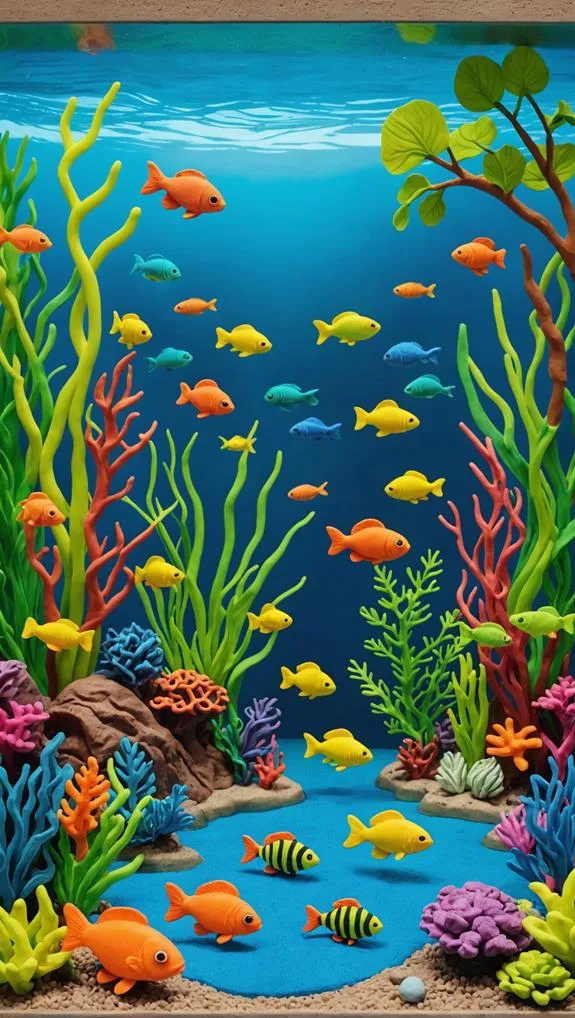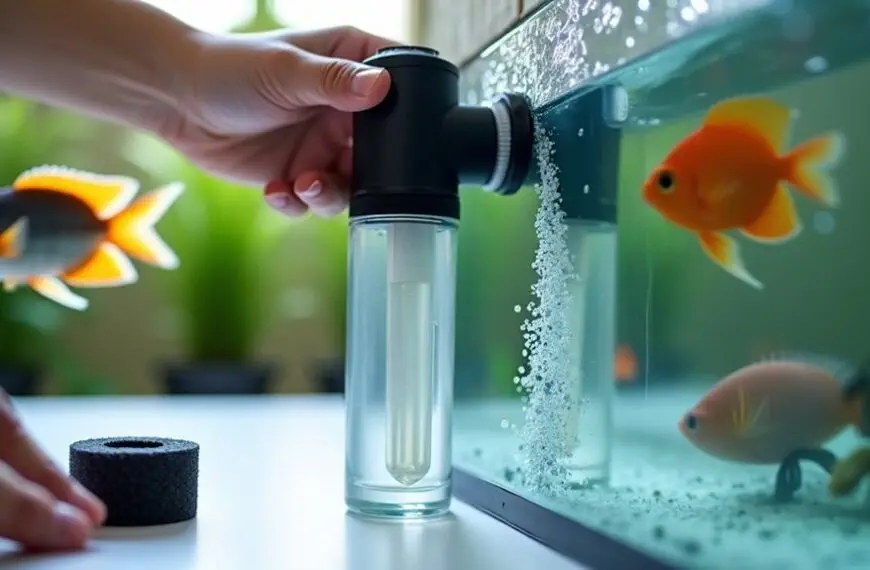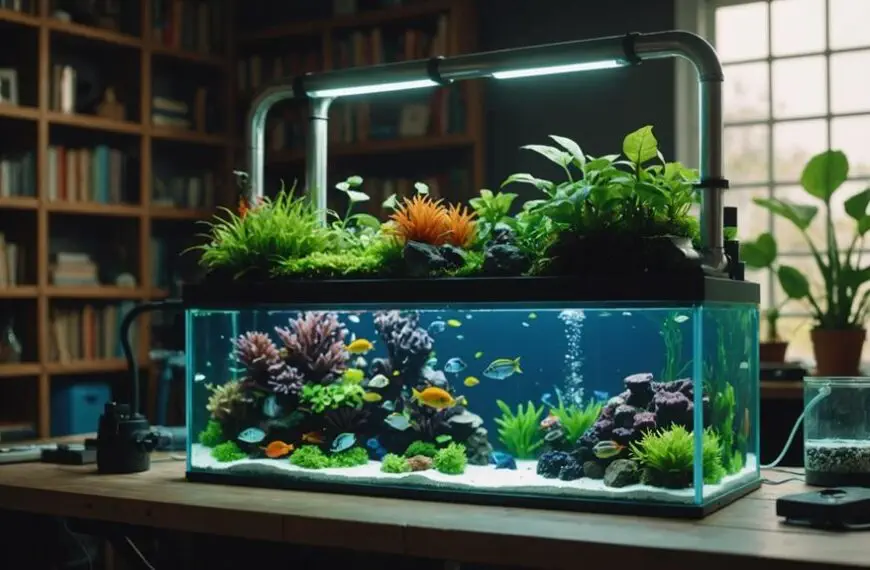Understanding how aquarium filtration systems function is key to keeping your fishy pals swimming happily. These systems not only clear the water but also remove nasty toxins like ammonia and nitrite. You've got three main types of filtration: mechanical, biological, and chemical. Each one does its part to keep your tank clean and your fish healthy. And don't worry, maintaining them doesn't have to be a chore! A little regular care can go a long way. Curious to learn the nitty-gritty of choosing the right filter and keeping it running smoothly? Stay tuned for more insights!
Contents
Importance of Aquarium Filtration
Aquarium filtration systems are vital for maintaining a healthy aquatic environment. Think of your filter as the unsung hero of your aquarium, tirelessly working behind the scenes. Good filtration removes toxic substances like ammonia, nitrite, and nitrate from the water, creating a safe space for your fish and plants to thrive.
Without it, even a small amount of ammonia from fish waste can become a serious threat, turning your beautiful aquarium into a dangerous place. Regular monitoring of water parameters is essential, as effective filtration systems help ensure that ammonia levels stay at 0.0 ppm, contributing to a stable environment for your aquatic life. Additionally, clean, balanced water is crucial for preventing stress and illness in fish.
Efficient filtration not only keeps the water clean but also helps reduce the frequency of water changes by about 50%. Who doesn't want a little less maintenance, right?
Plus, a good filter promotes gas and nutrient exchange by keeping the water moving. This is crucial for the health of your aquatic friends.
Types of Aquarium Filters
Maintaining water quality requires understanding the different types of filtration systems available for your aquarium. You'll find three main types: mechanical, biological, and chemical filtration, each playing its own vital role in keeping your fish happy and healthy.
Proper filtration is crucial for promoting stable nitrogen cycles, which helps to reduce harmful compounds in the water. Mechanical filtration is like your aquarium's bouncer, removing solid waste before it can decompose into harmful substances like ammonia. This keeps your tank's environment safe.
Then, there's biological filtration, which relies on beneficial bacteria to convert nasty ammonia into less toxic compounds. Healthy bacteria are your fish's best friends, helping to keep ammonia levels down.
Lastly, chemical filtration employs materials like activated carbon to absorb dissolved wastes, ensuring crystal-clear water. It's like having a magic sponge in your tank!
When choosing aquarium filters, think about your tank size and needs. Canister filters work wonders for larger tanks, while hang-on-back filters are user-friendly for most setups.
Sponge filters are perfect for small or breeding tanks.
With the right combination of these filters, you can ensure optimal water flow and quality, making your aquarium a thriving, vibrant ecosystem. Your fish will thank you!
Stages of Filtration Process

Understanding the stages of the filtration process is key to keeping your aquarium thriving.
You'll see that there are three main stages: mechanical, biological, and chemical filtration, each playing a vital role in ensuring your aquarium water stays clean and clear. An effective filtration system is essential for maintaining good water quality, which is crucial for fish health and longevity; regular monitoring of water quality management is also important for a balanced ecosystem.
First up is mechanical filtration. This stage removes solid waste particles from the water before they can break down into toxic ammonia. Think of it as your aquarium's first line of defense!
Next comes biological filtration, where beneficial bacteria work their magic. They convert toxic ammonia into nitrite and then into less harmful nitrate, which is great news for your fish. This process usually happens in porous materials that help these helpful bacteria grow.
Lastly, we've chemical filtration. This stage targets dissolved pollutants using materials like activated carbon, which adsorbs impurities. This not only improves water clarity but also enhances overall water quality.
With an efficient filtration system, you can cut your weekly maintenance by about 50%! So, by understanding these stages, you're not just helping your fish; you're making your aquarium a beautiful, healthy home for them, and that's something to smile about!
Key Components of Filters
When you think about your aquarium filter, it's like a little cleaning army working hard to keep the water fresh and healthy for your fish.
Each part, from filter floss to activated carbon, plays a crucial role in the filtration process, and they all need a bit of TLC to function well.
Filter Media Types
A well-functioning aquarium relies heavily on its filter media types, which play key roles in keeping the water clean and healthy for your aquatic life.
Understanding these types can help you serve your fish better and create a thriving environment.
Here are three essential filter media types you should know:
- Mechanical Filtration: This includes materials like filter floss and filter sponge. They trap small particles and debris, improving water clarity while providing surfaces for beneficial bacteria growth.
- Biological Filtration: Media rings and bio balls excel in this area. Their porous structure gives beneficial bacteria the space to thrive, which is crucial for converting toxic ammonia into less harmful substances.
- Chemical Filtration: Activated carbon is a must-have for removing dissolved pollutants. Just remember, it needs monthly replacement to keep your tank sparkling!
Using a combination of these filter media types ensures comprehensive filtration, helping maintain water clarity and the overall health of your aquarium.
Filtration Stages Explained
Aquarium filtration systems operate through three key stages: mechanical, biological, and chemical filtration. Each stage plays a vital role in creating a healthy home for your aquarium inhabitants.
Let's dive into how these processes work!
First up, mechanical filtration. It's like the bouncer at a club, removing solid waste particles from the water using filter media like foam or filter wool. This step helps prevent ammonia spikes that could harm your fish friends.
Next is biological filtration, where beneficial bacteria come into play. These tiny heroes thrive on porous media, converting harmful ammonia into less toxic nitrite and finally into nitrate. This transformation is crucial for maintaining your aquarium's overall health.
Last but not least, we've chemical filtration. Using activated carbon and other absorbent materials, it gets rid of dissolved pollutants and organic compounds, ensuring your water stays clear and balanced.
Maintenance and Care Tips
Proper maintenance is essential for the longevity and efficiency of your filtration system. By keeping a close eye on your filter components, you can ensure your aquarium thrives.
Here are three key tips to help you out:
- Rinse Mechanical Filters: Regular maintenance of mechanical filters like filter floss and sponges is crucial. Rinse them in tank water to avoid clogging and maintain optimal water flow.
- Replace Activated Carbon: Don't forget about your activated carbon! Replace it monthly to effectively remove pollutants and keep your tank water crystal clear.
- Care for Biological Media: Your biological media, such as media rings or bio balls, plays a vital role. Only rinse them in tank water if necessary, as chlorine in tap water can harm beneficial bacteria.
Remember to inspect and clean your filter parts regularly, too. This includes checking impellers and tubing to prevent mechanical failure.
Maintaining proper water circulation—aiming for 4-6 times your tank volume—helps keep your fish happy without creating too much chaos.
With a little effort, your filtration system can work like a charm, giving your aquatic friends the best home possible!
Selecting the Right Filter

When you're picking out the right filter for your aquarium, it's super important to think about your tank size and how many fish you've got swimming around.
You can choose from different types like hang-on-back filters for smaller tanks or canisters for the bigger ones, each with their own perks.
Plus, don't forget about maintenance—some filters are easy to clean, while others might need a bit more TLC to keep everything running smoothly.
Tank Size Considerations
Selecting the right filter for your aquarium hinges on understanding your tank's size and specific needs. Not only do you want crystal-clear water, but also a healthy environment for your aquatic friends.
Here are three key considerations for choosing the right filtration system:
- Flow Rate: A good rule of thumb is to have a filter that moves 4-6 times the volume of your tank per hour. For example, if you have a 20-gallon tank, aim for a filter rated at 80-120 GPH.
- Bio-load: Consider how many fish you have and their feeding habits. A higher bio-load will require a more powerful filter to maintain water quality.
- Larger Aquariums: If your tank is over 100 gallons, you may need multiple filters or larger models. This helps with effective circulation and keeps the water clean and healthy.
Filter Type Options
Choosing the right filter goes hand-in-hand with understanding your aquarium's size and bio-load. You want a filter type that suits your tank's needs, ensuring optimal water circulation.
For small to medium tanks, HOB filters are a favorite. They're easy to maintain and offer solid filtration while being visible in your aquarium. If you've got a larger setup over 30 gallons, consider canister filters. They pack a punch with customizable options but do require a bit more TLC.
For those breeding fish or maintaining smaller aquariums, sponge filters are a fantastic choice. They provide gentle water movement, promoting biological filtration and helping beneficial bacteria thrive, all without causing chaos in your tank.
Multi-stage filtration systems are another great option, as they combine mechanical, chemical, and biological filtration. This approach enhances water quality and balances your aquarium's ecosystem.
Ultimately, the right filter can make a world of difference in aquarium maintenance. It keeps your aquatic buddies happy and healthy, and let's be honest, who doesn't want that?
Happy fish, happy you! So, take your time, weigh your options, and choose a filter that fits your unique setup.
Maintenance Frequency Requirements
How often should you maintain your aquarium filter? The maintenance frequency really depends on your tank's bio-load and the type of filter you're using.
If your tank's packed with fish, you'll need to clean it more often to keep the water quality high and prevent clogging.
Here's a simple guide to help you out:
- Mechanical Filter Media: Rinse or replace this every 2-4 weeks. Just don't rinse biological media in tap water; you want to keep those beneficial bacteria alive!
- Canister Filters: These typically need a thorough cleaning and media replacement every 4-6 weeks, depending on your fish population and their messiness.
- Flow Rate Check: Keep an eye on your filter's flow rate. A drop can mean it's time for a filter check to prevent any issues.
Maintenance and Care Tips
Although aquarium filtration systems are essential for maintaining a healthy aquatic environment, they require regular upkeep to function effectively.
To keep your filters in tip-top shape, start by rinsing mechanical media, like sponges or filter floss, in tank water every 1-2 weeks. This helps remove solid waste without harming those precious beneficial bacteria. Just remember, avoid tap water!
Next, check your chemical filtration monthly. Replace activated carbon to ensure it effectively removes pollutants and keeps your water clarity sparkling.
As for biological media, such as bio balls or ceramic rings, don't rinse them with tap water either; you want to protect that colony of beneficial bacteria that breaks down toxic ammonia and nitrite levels.
Also, keep an eye on your filter's flow rate. Ideally, it should circulate 4-6 times the volume of your tank each hour.
Finally, regular water changes are crucial! They help manage the overall environment and can even reduce your maintenance needs by about 50%.
Frequently Asked Questions
How Does a Fish Tank Filtration System Work?
Your fish tank's filtration system works by cycling filtered water through filtration media, ensuring water clarity and promoting biological balance. This supports fish health, nutrient cycling, and environmental stability, enhancing overall tank maintenance and aquatic life well-being.
What Are the Three Types of Filtration Systems for Aquariums?
Ever wonder how to keep your aquarium thriving? You've got mechanical filtration for solid particles, biological filtration for harmful waste, and chemical filtration using filter media—ensuring optimal water quality and filtration efficiency in your setup.
What Is the Aquarium Filter Theory?
The aquarium filter theory combines mechanical, biological, and chemical filtration to ensure water clarity and aquarium health. You'll need efficient filter media and regular maintenance to support the nitrogen cycle and enhance filter efficiency, even with DIY filters.
What Is the Order of Filtration in Aquarium?
Imagine your aquarium as a thriving kingdom. You start with mechanical filtration to clear debris, then chemical filtration for water clarity, and finally biological filtration to nurture fish health, ensuring a balanced, harmonious environment.
Final Thoughts
In the grand aquarium of life, filtration is your trusty lifeguard, keeping everything in balance. By understanding how these systems work, you can create a vibrant underwater world for your fishy friends. Remember, choosing the right filter and giving it some TLC can make all the difference. So, dive in and enjoy the journey! Your aquatic companions will thank you, and you might even find a little piece of serenity beneath the waves.












